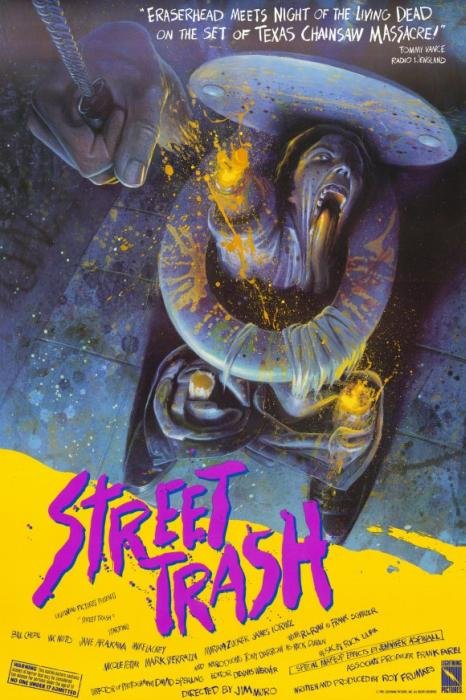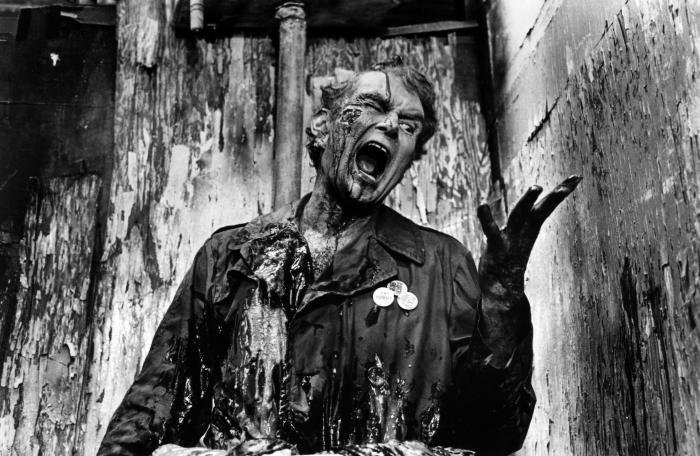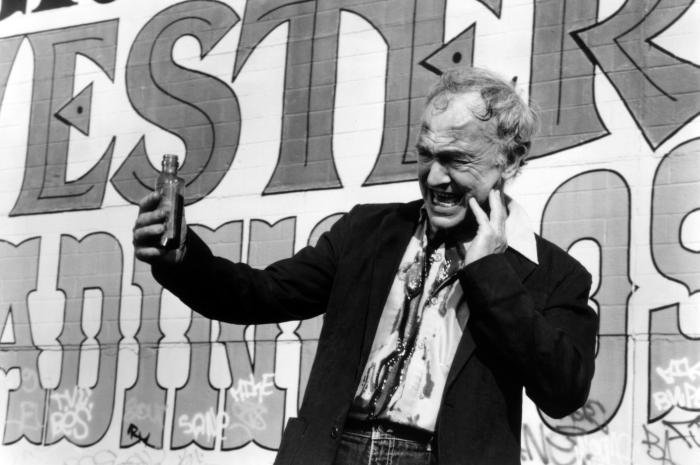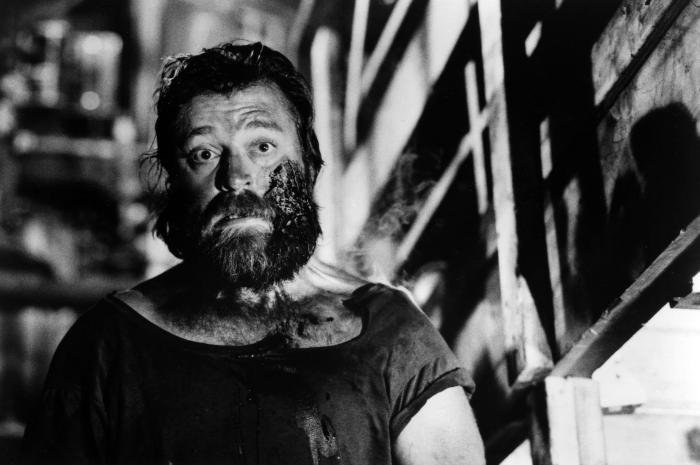STREET TRASH: Genre-Busting From The Heart Of Skid Row
Some cult movies earn their reputation because they excel in a particular genre and other cult movies earn their cult reputation because they defy genre classification altogether. Street Trash is a good example of the latter category. It is often confined to the horror genre because of certain elements of its premise but it's so much more: it combines grindhouse thrills, gory horror shocks, black humor of the darkest variety and even some allusions to Dodes Ka'Den and Huckleberry Finn.
In one of the more unique story hooks to emerge from '80s cult cinema, the premise of Street Trash revolves around poison hooch. A liquor store owner who peddles cheap booze to a primarily transient crowd finding a rotten crate of something called ‘Tenafly Viper’ in his cellar. He starts  selling it to bums, who discover the hard way that what is inside the bottle will cause them to melt (and in some cases explode) into piles of acidic, multicolored goo.
selling it to bums, who discover the hard way that what is inside the bottle will cause them to melt (and in some cases explode) into piles of acidic, multicolored goo.
But that's not all that is going on here: in fact, Street Trash has a surprisingly character-dense scenario. Runaway brothers Fred (Mike Lackey) and Kevin (Marc Sferrazza) are our nominal heroes, but we also have a gonzo Vietnam vet derelict (Vic Noto) who has flashback nightmares about vampire Vietcong, a tough cop (Bill Chepil) trying to stay on top on all of the bowery's crimes and a wiseass doorman (James Lorinz) whose habit of goofing off gets him in trouble with his mobster boss (a pre-Goodfellas Tony Darrow). The lethal hooch finds its way into all these subplots, making for mayhem of both gruesome and mordantly humorous varieties.
The resulting film is as confrontation as it is bizarre. In addition to the multicolored meltdowns, Street Trash also crams every sort of deviancy possible into its running time: rape, necrophilia, castration, and golden showers all get their day in the sun here and each is played for gallow laughs of the tackiest variety. It's the kind of movie where the victor of a fistfight shows his contempt for his  opponent by vomiting on him. Simply put, this is not for casual viewers or cult cinema dilettantes. It is nasty and unapologetically so.
opponent by vomiting on him. Simply put, this is not for casual viewers or cult cinema dilettantes. It is nasty and unapologetically so.
That said, if you have a strong stomach and a grim sense of humor, this film tells its oddball scenario with high levels of style and inspiration. Roy Frumkes’ often seems like it might slip into narrative anarchy, particularly given all the different tones it embraces, but there is a solid dramatic thru-line that pulls the episodic storyline together. It's an expansive, generous script that gives many of its characters room to shine - a particularly great bit is a moment when Burt (Clarence Jarmon) undetakes a shoplifting expedition at a grocery store - and the result is full of surprises from start to finish.
The ensemble bringing this tale to life is also particularly impressive. Lackey gives a pretty daring comic performance, fearlessly diving into the dark material without fear of alienating the audience, and Sferazza offers a nicely underplayed counterpoint that gives the film its core of humanity. The  other leads support this core nicely: Chepil was a real ex-cop who brings action hero-style credibility to his character's macho persona and Noto brings a fearsome Method intensity to his junkyard villain.
other leads support this core nicely: Chepil was a real ex-cop who brings action hero-style credibility to his character's macho persona and Noto brings a fearsome Method intensity to his junkyard villain.
That said, the bit roles are every bit as indelible as the leads: Darrow and Lorinz are the obvious scene-stealers, doing some hysterically funny improv riffing as the warring boss/doorman duo. Nicole Potter offers a fearless turn as the damaged "winette" girlfriend of Bronson, Jane Arakawa is lovely as the one person sympathetic to the runaway brothers and Jarmon offers a winning comic turn reminiscent of the Richard Pryor stand-up character Mudbone. Fans of Troma films will be amused by an appearance from R.L. Ryan, who is delightfully sleazy as the junkyard boss.
Even better, director Jim Muro and cinematographer David Sperling give the film a stunning visual gloss for a low budget effort. Together, they create a look that brings a vibrant sense of color to the slum locales, giving them a sort of gutter poetry. The restless, prowling camerawork  enhances the film's energy, particularly the frequent Steadicam shots. It's worth noting that Muro did the Steadicam work himself and later became an in-demand steadicam operator for directors like James Cameron.
enhances the film's energy, particularly the frequent Steadicam shots. It's worth noting that Muro did the Steadicam work himself and later became an in-demand steadicam operator for directors like James Cameron.
Finally, Jennifer Aspinall’s psychedelic gore effects are spectacular - the countless meltdowns have an almost Dali-esque touch to them. The results are some of the most unique makeup effects in any horror or cult item from the '80s (and that's saying a lot).
In short, Street Trash is the kind of film that should be approached with caution - but anyone brave enough to explore the singular niche it occupies will be rewarded with genre-defying shocks and thrills beyond their wildest dreams.


